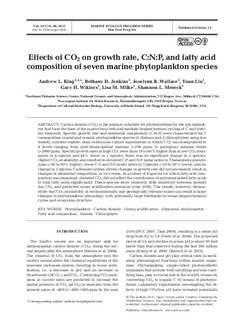| dc.contributor.author | King, Andrew Luke | |
| dc.contributor.author | Jenkins, Bethany D. | |
| dc.contributor.author | Wallace, Joselynn R. | |
| dc.contributor.author | Liu, Yuan | |
| dc.contributor.author | Wikfors, Gary H. | |
| dc.contributor.author | Milke, Lisa M. | |
| dc.contributor.author | Meseck, Shannon L. | |
| dc.date.accessioned | 2018-09-13T11:44:46Z | |
| dc.date.available | 2018-09-13T11:44:46Z | |
| dc.date.created | 2015-12-30T19:20:26Z | |
| dc.date.issued | 2015 | |
| dc.identifier.citation | Marine Ecology Progress Series. 2015, 537, 59-69. | nb_NO |
| dc.identifier.issn | 0171-8630 | |
| dc.identifier.uri | http://hdl.handle.net/11250/2562507 | |
| dc.description.abstract | Carbon dioxide (CO2) is the primary substrate for photosynthesis by the phytoplankton that form the base of the marine food web and mediate biogeochemical cycling of C and nutrient elements. Specific growth rate and elemental composition (C:N:P) were characterized for 7 cosmopolitan coastal and oceanic phytoplankton species (5 diatoms and 2 chlorophytes) using low density, nutrient-replete, semi-continuous culture experiments in which CO2 was manipulated to 4 levels ranging from post-bloom/glacial maxima (<290 ppm) to geological maxima levels (>2900 ppm). Specific growth rates at high CO2 were from 19 to 60% higher than in low CO2 treatments in 4 species and 44% lower in 1 species; there was no significant change in 2 species. Higher CO2 availability also resulted in elevated C:P and N:P molar ratios in Thalassiosira pseudonana (~60 to 90% higher), lower C:P and N:P molar ratios in 3 species (~20 to 50% lower), and no change in 3 species. Carbonate system-driven changes in growth rate did not necessarily result in changes in elemental composition, or vice versa. In a subset of 4 species for which fatty acid composition was examined, elevated CO2 did not affect the contribution of polyunsaturated fatty acids to total fatty acids significantly. These species show relatively little sensitivity between present day CO2 and predicted ocean acidification scenarios (year 2100). The results, however, demonstrate that CO2 availability at environmentally and geologically relevant scales can result in large changes in phytoplankton physiology, with potentially large feedbacks to ocean biogeochemical cycles and ecosystem structure. | nb_NO |
| dc.language.iso | eng | nb_NO |
| dc.publisher | Inter Research | nb_NO |
| dc.rights | Navngivelse 4.0 Internasjonal | * |
| dc.rights.uri | http://creativecommons.org/licenses/by/4.0/deed.no | * |
| dc.title | Effects of CO2 on growth rate, C:N:P, and fatty acid composition of seven marine phytoplankton species | nb_NO |
| dc.title.alternative | Effects of CO2 on growth rate, C:N:P, and fatty acid composition of seven marine phytoplankton species | nb_NO |
| dc.type | Journal article | nb_NO |
| dc.type | Peer reviewed | nb_NO |
| dc.description.version | publishedVersion | nb_NO |
| dc.rights.holder | © The authors 2015 | nb_NO |
| dc.source.pagenumber | 59-69 | nb_NO |
| dc.source.volume | 537 | nb_NO |
| dc.source.journal | Marine Ecology Progress Series | nb_NO |
| dc.identifier.doi | 10.3354/meps11458 | |
| dc.identifier.cristin | 1304930 | |
| cristin.unitcode | 7464,20,14,0 | |
| cristin.unitname | Marin biogeokjemi og oseanografi | |
| cristin.ispublished | true | |
| cristin.fulltext | original | |
| cristin.qualitycode | 2 | |

